Geochemistry and mineral chemistry of the armoor granitoids,eastern dharwar craton: implications for the redox conditions and tectono-magmatic environment
2024-03-06AjayKumarChAshok
A.Ajay Kumar • Ch.Ashok
Abstract The mineralogical and geochemical characteristics of the K-rich granites from the Armoor granitic rocks in the northeastern portion of the Eastern Dharwar Craton(EDC) are presented.In order to understand its physicochemical conditions,the petrogenesis of the granitoid was explained from biotite chemistry and geochemical systematics.Studies of mineral chemistry expose that compositionally,K-feldspar and plagioclase in Armoor granite rocks range from An0, Ab3-5.9, Or94-96.9 and An5-29,-Ab71.9-94.9, Or0-1.5, respectively.The mineral chemistry of biotite crystals exhibits composition that varies from primary to re-equilibrated primary biotites.Although biotites from the Armoor granites generally exhibit an I-type trend,with calc-alkaline parental magma in a subduction setting.Biotite chemistry of granites displays magnetite(oxidized)series nature,which has oxygen fugacity(fO2)=-15.1 to-16.7(log10 bar),under high oxidizing conditions.Temperature and pressure estimates for the crystallization of Armoor granites based on biotite composition are T=612–716 °C and 1.0-0.4 kbar,respectively.Geochemically,these rocks are metaluminous to slightly peraluminous and magnesian,with calc-alkaline potassiumrich granite.On the chondrite normalized REE diagram,the granites have positive europium anomalies;rich Sr/Y,(Dy/Yb)N ratios and reduced Mg#,Rb/Sr,Rb,Sr indicate that the melting of earlier rocks,crystal accumulation and residual garnet source formed at high pressures.The examined granites show that they are produced from the melting of crustal sources.Thus,the extensive analyses of the described Armoor granite suggest that they were produced by crust sources and developed under oxidizing conditions in subduction setting.
Keywords Armoor granites ∙Oxygen fugacity ∙Crystal accumulation ∙Remelting ∙Subduction
1 Introduction
The Neoarchean crust of the Eastern Dharwar Craton(EDC) consisted primarily of granitoids with diverse mineralogical,geochemical,and source characteristics(Dey et al.2017;Jayananda et al.2018,2020;Mohan et al.2019;Bhaskar Rao et al.2020).In the northern section of EDC,researchers have given significance to studying the origin and evolution of granitoids from field,petrography,geochemistry and geochronological aspects (Dey et al.2009,2017;Jayananda et al.2018,2019,2020;Mohan et al.2019;Bhaskar Rao et al.2020;Ajay Kumar et al.2022;Nagamma et al.2023).However,Mineralogical and Redox conditions studies are limited in the northern section of EDC (Ashok et al.2022a;Raju et al.2022).These studies provided valuable insight into the petrogenesis,physical and chemical environments of granites in connection with oxygen fugacity,temperature,and pressure(Kumar and Pathak 2010a;Bora and Kumar 2015;Anettsungla et al.2018;Babazadeh et al.2019;Azadbakht et al.2020;Sun et al.2020).
The northern section of the EDC in southern India is composed of granitoids comprising granite gneiss,tonalitetrondhjemite-granodiorite (TTG),and syeno-monzogranites,together with their corresponding mafic microgranular enclaves (MMEs) (Prabhakar et al.2009;Ashok et al.2022a,b;Raju et al.2022).The age of these basement TTG rocks corresponds to the middle to late Archean and is represented by (Chadwick et al.2000),subsequent by Archean to Proterozoic granitic events characterized by Closepet granite (Jayananda et al.1995).Due to differing scholarly opinions,the origin of these granitoids remains a topic of debate.These granitoid magmas are mostly linked with collisional or subduction rifting,intraplate,and oceanic settings (Manikyamba and Kerrich 2012;Moyen et al.2017;Jayananda et al.2018,2020).
The compositions and assemblages of common minerals in igneous rocks act as important tools that give crucial information about the magma’s origin,the varying physicochemical state of melt during crystallization,and the resulting rock’s post-solidus changes (Helmy et al.2004;Kocak et al.2011;Anettsungla et al.2018;Azadbakht et al.2020;Sun et al.2020;Ashok et al.2022a;Raju et al.2022).To quantity the emplacement temperature(T) and pressure (P) of calc-alkaline igneous rocks,the thermos-barometry of amphibole and biotite has been frequently utilized (Anderson and Smith 1995;Ridolfi et al.2010).Biotite,which is a ferromagnesian mineral,occurs in most felsic igneous rocks and can resist different temperature and pressure conditions(Yavuz 2003).The parent melt’s bulk composition largely determines mica composition and eventually re-equilibrates with the final volatile phase (Anettsungla et al.2018;Babazadeh et al.2019;Azadbakht et al.2020;Khosravi et al.2021).Therefore,biotite compositions may be utilized to detect various physicochemical properties of parent intrusions,viz.,under the particular environment,it is developed (Speer et al.1981;Tischendorf et al.2001),thus,chemistry of biotite is important in terms of investigating hydrothermal and magmatic progress (Cotten 1979),and the granitic rocks petrogenesis (Machev et al.2004;Kumar and Pathak 2010b;Y et al.2015;Sheykhi et al.2019).Moreover,the Fe3+/Fe2+of biotite may be utilized to examine the host magma’s oxygen fugacity (Wones and Eguster 1965;Wen et al.2017;Khosravi et al.2021).Also,the composition of biotite can be used to evaluate the equilibrium by analyzing the sub-solidus recrystallization or exchange processes amount within pairs and/or with some other minerals like potassium feldspar (Beswick 1973;Cotten 1979) and apatite (Wones 1980;Zhu and Sverjensky 1992;Sallet 2000).Felsic magmas,on the other hand,may be reduced or oxidized as a result of their interaction with pelitic country rocks and/or later tectonism initiated on the rocks(Cesare et al.2008;Singh and Kumar 2008;Kumar et al.2017).Many earlier research studies have established that biotite composition usage is a good reference to granite petrogenesis as well as tectono-magmatic setting (Singh and Kumar 2005;Kumar and Pathak 2010a;Anettsungla et al.2018;Babazadeh et al.2019;Azadbakht et al.2020;Khosravi et al.2021;Ashok et al.2022a).Furthermore,the traditional experimental studies show firmly developed the biotite is a reliable indication of granitic magma redox conditions (Wones and Eguster 1965;Wones 1972).The biotite composition may also be employed in certain situations as a tectono-magmatic indication (Abdel-rahman 1994;Nachit et al.2005).In this paper,the research discusses the mineral compositions acquired by electron microprobe analysis (EMPA) and major and trace elemental data of Armoor granitoid,with the following objectives are (i) to explain the mineral-chemical development of the Armoor granite,(ii) to determine the physicochemical settings (crystallization temperature and pressure,and oxygen fugacity) that prevailed in the crystallization of the magma,and (iii) provide clues to their petrogenesis and role of crystal accumulation,hydrothermal alteration and geotectonic evolution in the Armoor granites.
2 Geological setting
The Dharwar Craton (DC) in southern India (Fig.1a)corresponds to a massive oblique section of the Archaean continental crust with a long crustal history extending from 3.6-2.5 Ga and is a significant wide hot orogeny toward the end of the Neoarchean period (Chardon et al.2011).This craton contains large regions of polyphase TTG gneisses locally recognized as peninsular gneisses,two generations of volcanic-sedimentary greenstone phases(younger Dharwar Super Group and older Sargur Group),SHRIMP U-Pb zircon ages as 2.62 and 3.0 Ga (Manikyamba and Kerrich 2012;Hokada et al.2013;Jayananda et al.2013;Dey et al.2015,2018;Manikyamba et al.2015;Khanna et al.2016) and calc-alkaline 2.57 to 2.50 Ga to High-K granitoid plutons (Jayananda et al.2018,2019,2020;Mohan et al.2019).It is divided into two crustal blocks such as the EDC and Western Dharwar Craton(WDC),based on the metamorphic patterns,structures,TTG-greenstones-granites abundance,and crustal thickness(Chadwick et al.2000;Jayananda et al.2006,2020;Chardon et al.2008,2011).The steep mylonitic shear region along with the eastern limit of the Chitradurga belt,is identified as the separation line between the two crustal blocks (Chadwick et al.2000;Chardon et al.2008).

Fig.1 a Geological map of the Dharwar craton (modified after Nagamma et al.(2022).b Geological map of the Armor granites showing the exposures of granitoids
The Dharwar craton preserves Paleoarchean to Neoarchean magmatism connected with crust formation and reworking,which largely evolvement to the development of the continental crust (Chadwick et al.2000;Jayananda et al.2018;Bhaskar Rao et al.2020;Nagamma et al.2023).The Archaean basement within EDC is predominantly made up of 2.7 Ga tonalitic to granodioritic gneisses,with substantial remnants of 3.0 to 3.38 Ga TTG with greenstones Sargur-type with interlayers (mostly occurring as discontinuous 4-6 km long bands confined to the EDC’s southwestern portion),volcanic-dominated greenstone belts ranging from 2.7 to 2.54 Ga,and the most voluminous N-S trending calc-alkaline plutonic belts ranging from 2.57 to 2.52 Ga (Friend and Nutman 1991;Nutman et al.1996;Balakrishnan et al.1999;Chadwick et al.2000;Jayananda et al.2000;Chardon et al.2008;Dey et al.2012;Gireesh et al.2012).At 2.52 Ga,the basement TTG initiated reworking,which was connected to significant juvenile magmatic accretion and widespread shear deformation (Jayananda et al.1995,2000,2018;Krogstad et al.1995;Bhaskar Rao et al.2020).High-T metamorphism and low-pressure impact the EDC,with conserved assemblies correlating to a dynamic transition from amphibolite into granulite facies dated at ca.2.5 Ga(Peucat et al.1993;Chadwick et al.2000;Chardon et al.2008;Jayananda et al.2013).The Archaean Granitic Complex of the study region Nizamabad contains huge expanses of the territory comprised of various granitic intrusions.The Armoor Area constitutes a part of the Nizamabad District in Telangana State and is dominated by granites emplaced in a basement of TTG (Fig.1b).The State Capital Hyderabad is roughly 181 miles southeast,and the district headquarters,Nizamabad,is about 27 km from the study area.The study area under investigation is spread over about 110 km2with an oblate outline.Compositionally,the Armoor granite exhibits grey granite to pink granite;it shows syenogranite to monzogranite(Fig.2a and b).Pink granite is pinkish to whitish grey color,whereas grey granite is whitish grey to grey color.These show sharp contact with hosted mafic magmatic enclaves and TTGs.Both granitic types consist of feldspar phenocryst and many late magmatic injections such as quartz veins,pegmatite veins,and other fluid interactions noticed in the study area.The mafic magmatic enclaves have interacted with host granites governing to magma mixing and mingling,which limited study in the northern part of EDC(Shukla and Mohan 2019;Ashok et al.2022b;Raju et al.2022).

Fig.2 a Sub-rounded enclave hosted in medium-grained grey granite.b Sharp contact between enclave and pink granite.c Microcline is displaying crosshatched texture associated with quartz grains.d Large perthite texture observed in grey granite with altered biotite.e Laths of biotite crystals (PPL),f XPL
3 Analytical procedures
The thin rock section was made and obtained petrographic characteristics at the Department of Geology,Osmania University,Hyderabad.The chemical analysis of feldspars and biotites from granite samples was performed on a carbon-coated polished portion with CAMECA SX 100 EPMA (Electron Probe Micro Analyzer) at the Geological Survey of India,Hyderabad.To accelerating voltage and beam current,the Faraday cup was set at 15 kV &12 nA.A beam diameter of 5 l m was retained for the analysis of biotite.Natural and synthetic minerals were utilized as standards for calibration given by CAMECA.After repeated assessments of relevant standards,it was discovered that the inaccuracy of the major elements was less than 1%.Ferrous iron is the term used to describe total iron.
Granite samples were crushed and powdered using an agate mill and a 200-mesh pulverizer.The X-Ray Fluorescence Spectrometer (XRF) at the CSIR-National Geophysical Research Institute (CSIR-NGRI),was used to determine the major element concentrations of pressed pellets with a relative standard deviation of 3%;the analytical method is described by(Krishna et al.2007).Using the closed digestion process,materials were dissolved for trace element analysis.In 10 mL Saville containers containing a 7:3 HF:HNO3acid combination,50 mg of representative sample powders were dissolved for 48 h at 150°C in a 7:3 HF:HNO3acid mixture.After digestion,two to three drops of perchloric acid (HClO4) were added to the mixture,which was then evaporated until dry.Combine 20 mL of freshly prepared 1:1 HNO3and keep it at 80 °C for 10–15 min.After getting a clear solution,5 mL of Rh(1 ppm concentration) was added as an internal standard,and then 250 mL was produced.This solution was diluted to the correct TDS content by adding 5–50 mL of water(total dissolved solids).Geological Survey of Japan-approved reference materials (JG-2 and JG-1) were used as standards for the examination of major and trace elements.The reference materials used to determine the accuracy and repeatability of the majority of trace components have an RSD of 5%.
4 Petrography
In the study area,pink and grey granites are distinguished by medium to coarse,equigranular to porphyritic,and hypidiomorphic textures.These granites consist chiefly of quartz,plagioclase (albite-oligoclase),K-feldspar (orthoclase and microcline),and biotite,along with the zircon magnetite and sphene as accessory phases.Pink granite has a larger concentration of K-feldspar than plagioclase feldspar,whereas grey granite has a higher concentration of plagioclase than K-feldspar.Microcline with cross-hatched twinning characterizes K-feldspar,which is medium,subhedral to anhedral (interstitial)(Fig.2c).Exsolution as well as intergrowth textures such as granophyres and perthite (Fig.2d),are particularly widespread.The study area consists most prevalent ferromagnesian mineral is biotite.The biotite grains in Armoor’s granite are greenish-brown (Fig.2e and f),implying oxidized I-type intrusions as a host (Lalonde and Bernard 1993) (Fig.5a).These subhedral to euhedral grains are relatively large and exhibit little alteration to chlorite (Fig.2f),and include ilmenite,apatite,magnetite,and zircon as inclusion minerals.At spots,biotite poikilitically encloses zircon,magnetite,and titanite with pleochroic haloes and is seldom converted to chlorite(Fig.2e and f).
The granites have dominantly observed crosshatched twining microcline and hosted plagioclase and quartz crystals,which might influence deformation (Fig.3a).The microstructure of perthite is characterized by the intergrowth of alkali feldspar and plagioclase and surrounded by undulose quartz,which indicates to deformation(Ashok et al.2021;Nagamma and Ashok 2022) (Fig.3b).Plagioclase was strongly sericitized and featured twinned albite polysynthetic structures (Fig.3c).Rarely,alkali feldspar exhibits sericite alteration (Fig.3d).Sericitization indicates that the process of alteration has reached low temperatures.Biotite often appears as distinct laths or aggregates transformed into chlorite and epidote.This unaltered plagioclase (Ab71.9-75.0) exhibits oligoclase composition,whereas altered and mixed plagioclase(Ab92.0-95.0) falls in the albite field of the Or-Ab-An diagram (Fig.5a).

Fig.3 a Microcline exhibiting crosshatched twining with quartz and plagioclase crystals in Armoor granite.b coarse-grained perthite hosted quartz crystals and was surrounded by undulose quartz.c Plagioclase feldspar display twining associated seritization and recrystallized quartz crystals.d Alkali feldspar and biotite are altered to sericite and chlorite and are surrounded by quartz and feldspar minerals
The mineral growth textures are observable under polarized microscopy.Furthermore,backscattered electron(BSE) images have been widely used in investigating mineral morphological structures,focusing on their chemical variability.In this work,the examination revealed the presence of micropores,microcracks,and textures associated with magmatic and post-magmatic crystallization in feldspar and biotite (Fig.4).These crystals were euhedral to subhedral texture and porous nature.Alkali feldspar consists of porous plagioclase,albite-rich plagioclase (Fig.4a).The plagioclase feldspar contains tiny alkali feldspar and biotite crystals and seritization(Fig.4a).Large plagioclase patch inserted into alkali feldspar with small inclusions (Fig.4b).Mixed of alkali feldspar and plagioclase feldspar produced albite-rich plagioclase(Fig.4d).Biotite poikitically enclosed plagioclase and associated Fe-Ti oxides (Fig.4c and d).Plagioclase and biotite are coupled with large Fe-Ti oxides(Fig.4a and d).Chlorite flakes are generally associated with biotite,which is alteration product (Fig.4d).

Fig.4 BSE images of Armoor granites:a Large alkali feldspar enclosed plagioclase and albite rich plagioclase with porous nature.b Albite-rich patch plagioclase within alkali feldspar associated with biotite.c Large biotite crystals hosted plagioclase crystals and small Fe-Ti oxides and were subrounded by quartz.d Chlorite flakes and Fe-Ti oxides were observed within biotite surrounded by plagioclase and mixed alkali feldspar and albite-rich plagioclase
5 Results
5.1 Mineral chemistry
5.1.1 Feldspar
Armoor granites were represented by 7 alkali feldspar compositions that were analyzed on the basis of 8 oxygen per atom (Table 1).Orthoclase dominates the composition of alkali feldspar in examined granites (Fig.5a).Or94.0to Or96.9and Ab3.0to Ab5.9,are the compositions of alkali feldspar in the studied region.The most prevalent mineral in the examined rocks is a plagioclase feldspar.Table 2 lists typical plagioclase analyses and mole percentages(mol%) of anorthite,albite,and orthoclase calculated on eight oxygen per atom bases from 15 plagioclase spot analyses performed on Armoor samples.Plagioclase composition of the Armoor granite ranges from An3.6to An29.5,Ab71.9to Ab95.0,and Or0to Or1.5,respectively.The majority of these compositions are Oligoclase(Ab71.9-75.0)and Albite (Ab92.0-95.0) (Fig.5a) (Deer 1992).This characteristic is compatible with fractional crystallization,playing a pivotal role in influencing the evolving magma composition in the chamber.
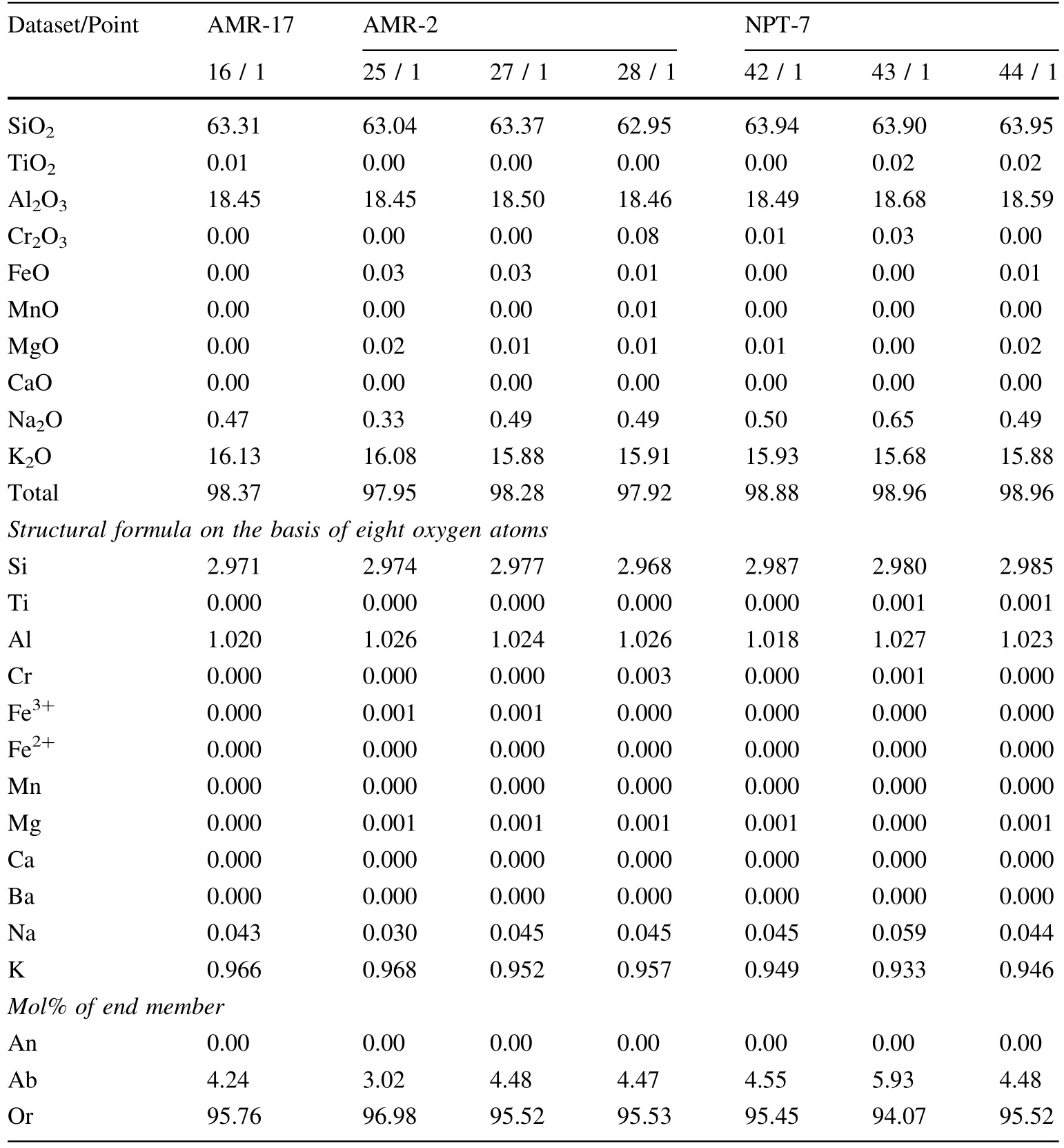
Table 1 Calculated values of selected K-feldspar minerals from the Armoor granites
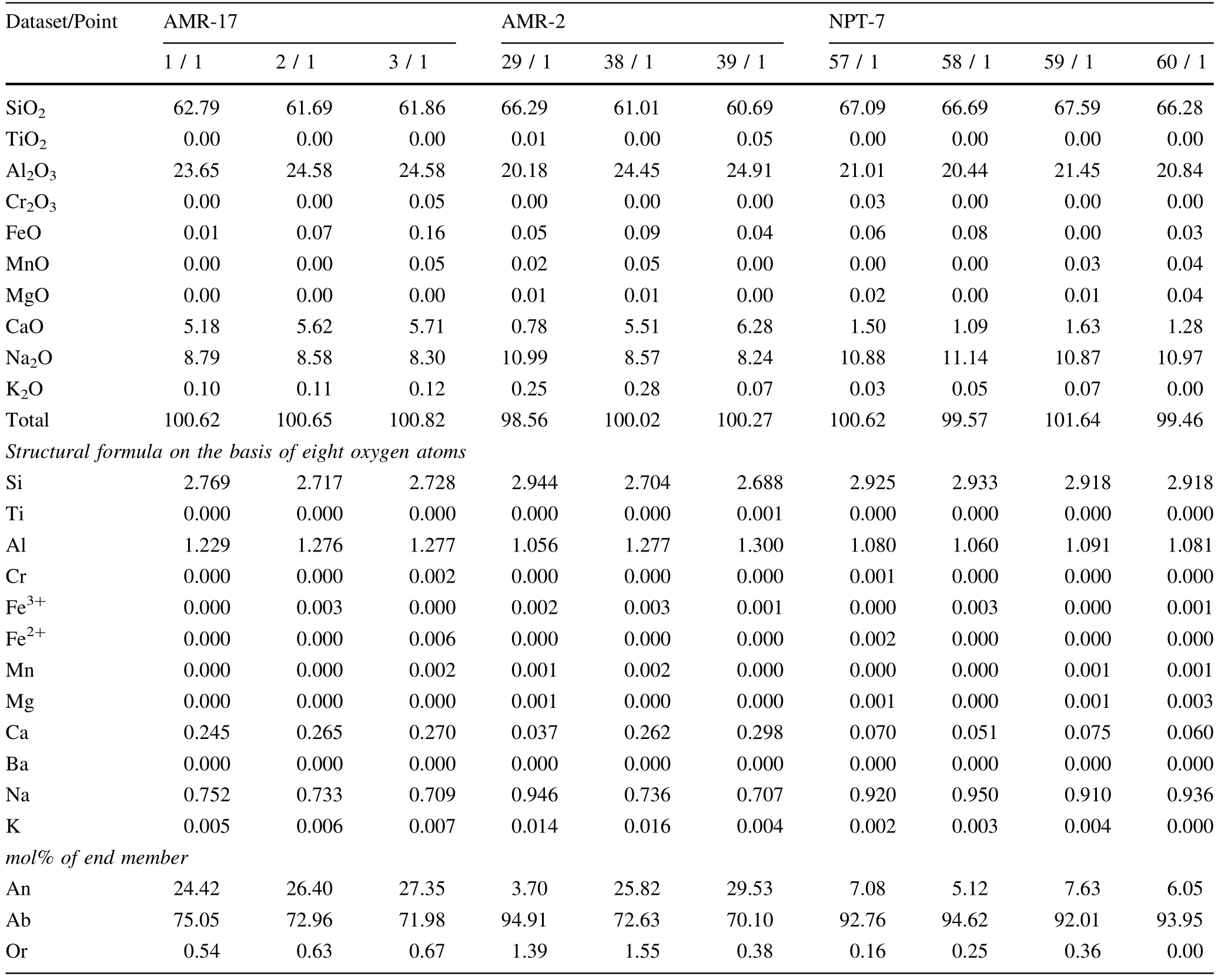
Table 2 Calculated values of selected Plagioclase minerals from the Armoor granites
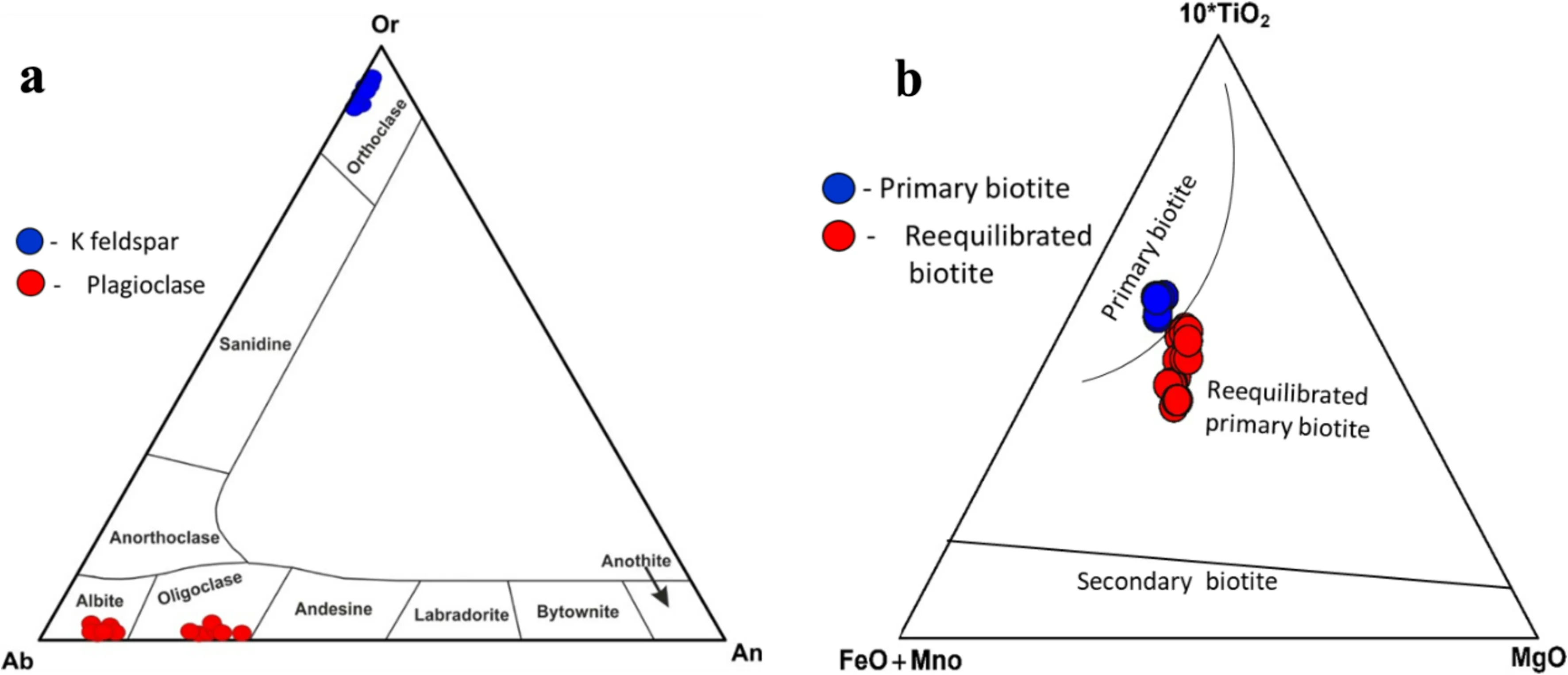
Fig.5 a Classification diagram of Or-Ab-An for the feldspars from Armoor granitoids(after Deer 1992).b Primary and re-equilibrated nature of Armoor biotites as revealed from the TiO2– FeO+MnO– MgO triangular plot (after Nachit et al.2005)
5.1.2 Biotites
The composition of biotites of the studied granite is shown in Table 3,and formulae were determined on an anhydrous base of 22 oxygen per atom.The sum of the primary and reequilibrated biotite analysis’s major oxides ranges from 96.1 to 97.7 wt% and 91.75 to 95 wt%,respectively,indicating a variable amount of halogen and OH ions occupancy in the biotite structure.Based on the mineral chemistry of biotites,the Armoor biotites are divided into two types such primary biotites and reequilibrated biotites.The primary and reequilibrated biotites display compositions with FeO=20.5-22.4 and 16.74-19.1 wt%,Al2-O3=14.1-14.7 and 14.99-16.19 wt% and K2O=8.4-9.6 and 8.77-9.67 wt%,respectively.TiO2is more abundant in the primary biotites than reequilibrated biotites,with levels ranging from 3.7-3.9 and 1.9-3.12 wt%,respectively.The octahedral coordinated mole fractions Mg2+,Fe2+,and Fe3+in the biotite imply that their type is primary to reequilibrated biotites (Fig.5b) (Nachit et al.2005),which the reequilibrated biotites impacted by hydrothermal modification (Wones 1980).

Figure 6a depicts the composition of Armoor biotites in the annite-siderophyllite-phlogopite-eastonite quadrilateral.In general,I-type biotite has more Si and Fe and less AlIVthan S-type biotite;both biotite compositions define a trend for I-type granites (Fig.6b) (Villaseca et al.2017).The FeOt/MgO ratio of both biotites in granites fluctuates between 1.40 and 2.0,with a mean value of 1.63.These ratios are comparable to those of Mg-biotites (FeOt/MgO=1.69),which are typically associated with amphibole in calc-alkaline(mostly orogenic but also subductionrelated) I-type granitoid complexes (Abdel-rahman 1994).Armoor biotite has a greater Fe2+/(Fe2++Mg) ratio,as well as an iron-enrichment index,with higher SiO2concentrations ranging from 35.17 to 37.64 wt%.Abdel-rahman(1994)presents a discrimination diagram based on the major-element structure of biotite in igneous rocks crystallized from three distinct magma types.Armoor biotites’FeOtvs MgO and FeO vs Al2O3components indicate evidence of crystallization in a subduction-related calcalkaline orogenic magma (Fig.7a,b).

Fig.7 a Al2O3 vs MgO,b MgO vs FeOt plots discriminate the host granitoid melt types formed in subduction related calc-alkaline Orogenic suites (after Abdel-Rahman 1994)
5.2 Temperature and pressure estimations
A study postulated that the Ti concentration of biotite might be used as a geothermometer for graphitic,peraluminous meta-pelites containing rutile or ilmenite and equilibrated mately at 4 to 6 kbar (Henry et al.2005).The proposed method has been applied to granitoid and pegmatitic rocks and appears to produce a reliable exchange temperature estimate (Cesare et al.2008;Moshefi et al.2018).Since the majority of biotite grains lie within the specified calibration composition as well as temperature range (T=612–716 °C) for this geo-thermometer,the exchange temperature of magmatic biotite was estimated using the previously published equation (Table 3).The primary biotites shows higher temperature (712-716 °C)than re-equilibrated biotite (612–699 °C).A research in Japan demonstrated an empirical equation utilizing the total Al concentration of biotite to determine the solidification pressure of barren and fruitful intrusions (Uchida et al.2007).The primary biotites show lower pressure(1.0-1.4 kbar) than reequilibrated biotite (1.6-2.4 kbar).
5.3 Oxygen fugacity (fO2)
Usually,the biotite colour in-plane polarized light is commonly used to measure the oxidation level of the magma in which it is formed;the greenish-brown biotite of Armoor granites implies a higher oxidizing environment(Azadbakht et al.2020).The felsic intrusions of fO2may also be determined with Fe2+/(Fe2++Mg2+) concentration of biotite occurring with K-feldspar and magnetite following the calibration by (Wones and Eguster 1965).The Fe2+/(Fe2++Mg2+)vs total Al of Armoor granite display magnetite series with high fO2(Fig.10a)(Anderson et al.2008),it implies crystalizing under oxidized circumstances.The Armoor biotites solidified at the high oxidizing state(Fig.10b)of biotite development under NNO buffer,where primary biotites oxygen fugacity(fO2)=-15.2 to-15.4(log10bar);T=712-716 °C and reequilibrated biotites oxygen fugacity(fO2)=-15.1 to-16.7(log10bar);T=612-699°C(Wones 1972,1980).These biotites are solidified and developed under the high oxidizing condition of Armoor granites.
5.4 Geochemistry
The Armoor granitic rocks are dominantly composed of silica (71.5–73.5 wt%),CaO (1–1.9 wt%),and minute quantities of MnO,MgO,and TiO2.The granites include a moderate amount of total alkali (8.7–9.7 wt%) and a moderate to high amount of aluminium (13–13.8 wt%)(Table 4).K2O concentrations in granites range from 4.8%to 6.4%,whereas Na2O concentrations range from 3.1%to4.2%.Pink granites have lower concentrations of Fe2O3,MgO,CaO,Na2O,and TiO2than grey granites and higher concentrations of SiO2and K2O than grey granites(Table 4).A connection between three variables Ab–Or–An illustrates an excellent classification of granitoids based on the mineral compositions of sequence with solid solutions,the majority of which are found in the granite field(Barker 1979) (Fig.8a).These granites range in composition from metaluminous to peraluminous (Fig.8b) (Frost et al.2001).The granites have a low Fe#(Fig.8c),indicating that the Armoor samples are magnetic in nature(Frost et al.2001).These granites have a higher MALI(Modified alkaline lime index),suggesting a typical alkalicalcium composition for continental arc rocks (Fig.8d).Large ion lithophile elements (LILE),such as Ba,Rb,and Sr,are more prevalent in granite samples than high field strength elements (HFSE) with a higher Sr/Y ratio(Table 5).Chondrite-normalized REE patterns (Nakamura 1974) demonstrate low to high fractionation of LREE/HREE [(La/Yb)N=7-132] and moderate fractionation of LREE/MREE [(La/Sm)N=1.6-15.8] in Armoor granites(Fig.9a).In the Normalized primitive mantle diagram,granites have strong positive Rb,Th,U,K,and Pb anomalies and significant negative Ba,Nb,P and Ti anomalies,which indicate to the vital role of crust and subduction zone setting (Fig.9b) (Sun and McDonough 1989).

Table 4 Major oxides (wt%) of Armoor granites from the northern part of Eastern Dharwar Craton,Telangana
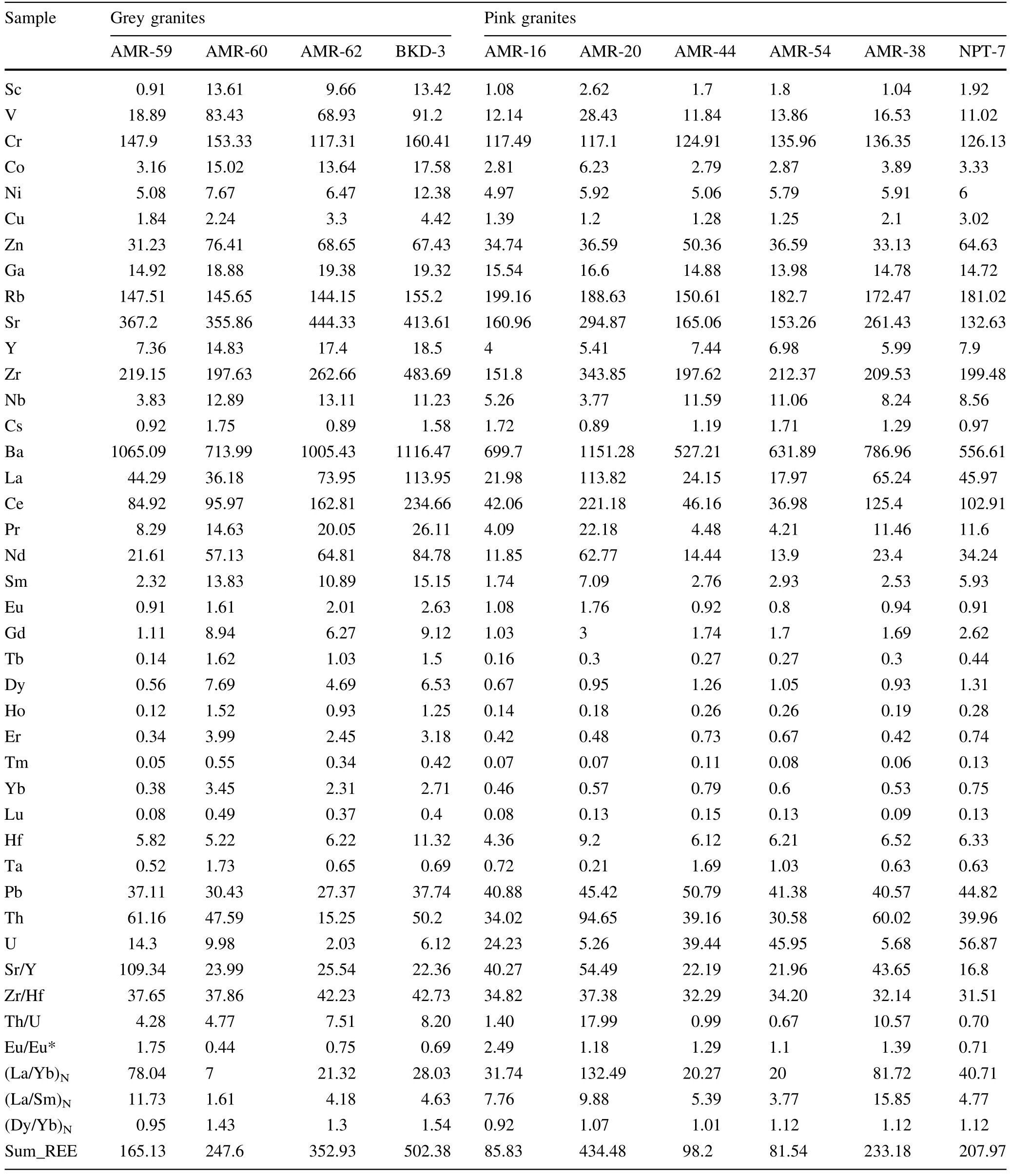
Table 5 Trace and REE compositions (ppm) of Armoor granites from the northern part of Eastern Dharwar Craton,Telangana

Fig.8 a Ternary diagram An–Ab–Or displaying granite field(O’Conner 1965).b Armoor granite shows a metaluminous to peraluminous nature in a diagram based on the(Frost et al.2001).c Fe#vs SiO2 shows the investigated rocks scatter in the ferroan and magnesian granite fields(Frost et al.2001).d SiO2 vs MALI(Modified alkaline lime index)diagram indicates the alkali-calcic character of Armoor granites(Frost et al.2001)

Fig.9 a Chondrite normalized REE patterns of Armoor granites exhibit LREE enrichment and HREE depletion(Nakamura 1974).b Primitive mantle normalized trace element distribution pattern of Armoor granite (Sun and McDonough 1989)
6 Discussion
6.1 Mineralogical implications
Biotite’s chemical composition might be used to investigate the physicochemical components of its parent magma,such as temperature,pressure,and oxygen fugacity(Wones and Eguster 1965;Henry et al.2005;Uchida et al.2007;Babazadeh et al.2019;Azadbakht et al.2020;Khosravi et al.2021).Moreover,the biotite color represents the estimated oxygen fugacity of the granite magma,with greenish-brown biotite (Al and Ti-poor and Mg,Fe3+enriched) suggesting that granite magma is oxidized(Lalonde and Bernard 1993;Azadbakht et al.2020).In addition,the reddish-brown colour of biotite in Sn–W-related intrusions implies magma crystalized reduced conditions (Azadbakht et al.2020).
Based on petrographic observations (textural correlations) and estimated P–T conditions,it is difficult to determine whether biotite crystallized before or after hornblende in these rocks.Magnesium-rich biotite is frequently found in the same rocks as Fe–Ti oxides,and simultaneous growth indicates an oxygen fugacity (fO2) in the melt that is rather high(Wones and Eguster 1965).The Fe3+/Fe2+ratio in the melt increases as the oxygen fugacity of magmatic systems increases,allowing less Fe2+to compete with Mg2+for site occupancy in mafic minerals.Consequently,when fO2rises,the Mg#of mafic minerals will increase,and it seems that high Mg#in mafic minerals is indicative of magmas with a high fO2content.Utilizing the calibration curves of (Wones and Eguster 1965;Wones 1980) in fO2–T space,oxygen fugacity values may be analyzed from the Fe2+/(Fe2++Mg2+)ratio of the biotite.
The assemblage of titanite+magnetite+quartz in granitoid rocks enables the estimation of relative oxygen fugacity (Wones 1989).When magnetite is present in agranitic rock assemblage,it is widely accepted that I-type granites are more oxidized than S-type granites (Chappell and White 1992;Helmy et al.2004;dos Santos Dias et al.2019).The calculated fO2values for the Armoor samples fall within a restricted range of oxygen fugacity (fO2)-=-15.1 to-16.7(log10bar),i.e.,in the Ni–NiO(NNO)buffers.The majority of biotite compositions in Armoor granitic rocks exhibit Fe#values between 0.43 to 0.50,resulting in FQM values between+1.1 to+2.6(Fig.10a).Our observations suggest that the Armoor samples crystallized under relatively high fO2conditions.Wones and Eguster (1965),introduced the log fO2–T plot to calculate the balanced biotite+sanidine+magnetite magmatic oxygen fugacity.T–fO2calculations for the Armoor granitoids equilibrated at oxygen fugacity’s between-5.1 to-16.7 indicate crystallization conditions in Ni–NiO (NNO) buffer for all the examined samples,suggesting a relatively high oxidation condition during magma crystallization (Fig.10b).Magmas originating from the upper mantle have a lower oxygen fugacity FQM(-4 to+3) than magmas derived from the crust(FQM=-2 to+5) (McCammon 2005;Nebel et al.2015;Babazadeh et al.2019).The relatively high Oxygen fugacity(fO2) (FQM=1.1 to 2.6) of Armoor samples allows for much greater crustal contributions.
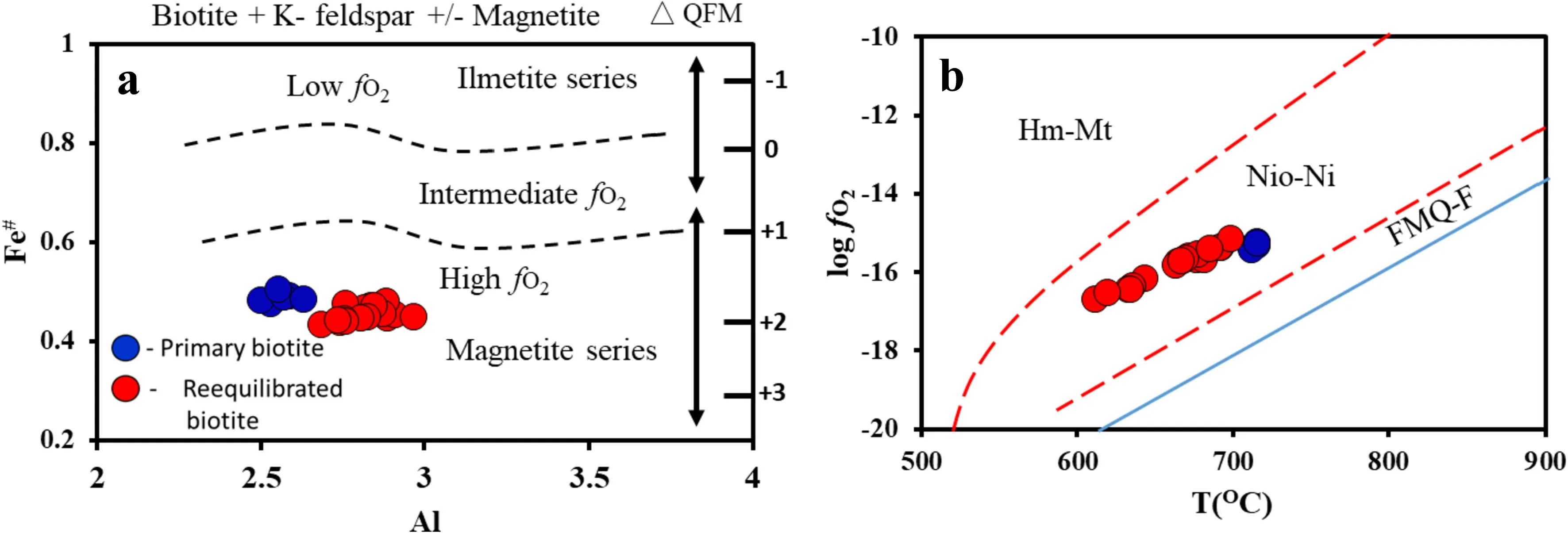
Fig.10 a Binary Al vs Fe#[Fe2+/(Fe2++Mg2+)]plot(apfu)for biotites showing high fO2 and magnetite series(Anderson et al.2008).b Log fO2–T diagram based in biotite chemistry (Wones 1972,1980),illustrating the redox conditions of Armor biotites
6.2 Geochemical implications
The Neoarchean granitic activity marks the Archean–Proterozoic boundary in the Dharwar Craton,a crucial event in the processes of crustal formation and remelting(Jayananda et al.2013).Numerous factors influence the Neoarchean granitoids of EDC,including source structure,melting depth and degree,separation or fractional crystallization,magma mixing,crustal accumulation,and fluid activity (Moyen et al.2003;Smithies et al.2003;Martin et al.2009;Moyen and Martin 2012;Laurent et al.2014).The present study examines the K-rich Armoor granites of EDC,which exhibits a distinct composition of plagioclase,as well as variance in Ba,Sr,Rb,and Zr concentrations,as well as Zr/Hf,(Eu/Eu*),and LREE ratios,all of which represent crystal accumulation and hydrothermal alteration.Based on the above geochemical characteristics of pink and grey granite of Armoor granites affected by plagioclase accumulation and hydrothermal alteration,a detailed description is given in the following sentences.
As a result of the early separation of magnetite and amphibole (garnet) and the suppression of plagioclase fractionation in high pH2O and fO2settings,chronically high Sr/Y ratios(16-109)and calc-alkaline tendencies are seen(Zimmer et al.2010).Several investigations have shown that garnet and amphibole,relics of their parent rocks,display significant Sr/Y and La/Yb dissolution(Lieu and Stern 2019;Nandy et al.2019).Amphibole,which has a partition coefficient Kd for MREE that is greater than one,consolidates MREE more than HREE,whereas garnet consolidates HREE more than MREE (Davidson et al.2007;Khosravi et al.2019).Garnet-rich residues would have a larger Dy/Yb(0.92-1.54)ratio during melting than amphibole-rich residues.These results indicate that the no influence of amphibole residue in Armoor granites and the high Sr/y ratio suggest that plagioclase accumulation (Macpherson et al.2006;Davidson et al.2007;Khosravi et al.2019;Nagamma et al.2023).Additionally,petrographic evidence of accumulation,such as large euhedral crystals,dark mafic inclusions feldspar phenocrysts,and recrystallization of plagioclase and K-feldspar (Fig.2c,d).A clear study on feldspar accumulation with the help of mineralogical and experimental limitations as they indicates widespread and regular recrystallization of the host granites and granodiorites(Glazner and Johnson 2013).In both plutonic(Lowery Claiborne et al.2006) and volcanic (Reid et al.2011) processes,the results of zircon fractionation (lowered Zr/Hf ratio) and aggregation (increased Zr/Hf ratio) have been reported.Additionally,the Eu anomaly (Eu/Eu*) and Sr concentrations help to understand the crystal accumulation in the granitic rocks.The higher Ba,Sr,and Zr/Hf(31.5-42.7) ratio and Eu/Eu* (0.14-2.4) ratio are present in Armoor granite which is the most promising indicator of crystal accumulation.The Eu anomalies can be used to clarify the function of feldspar in source melting,thus helping understand the magma emplacement process (Tata et al.2018;Khosravi et al.2019).
It has been shown that mineral fractionation modifies the Eu’s chemical behavior.As a consequence of plagioclase fractionation during magma formation,these granites display strong positive Eu anomalies (Eu/Eu*=1.1 to 2.4)(Macpherson et al.2006;Davidson et al.2007).Positive Eu deviations in granitoids may be linked to plagioclase consumption as a source accumulation in the magma chamber (Macpherson et al.2006;Davidson et al.2007).There was no substantial association between the Na2O,CaO,and Sr components and the Eu deviations in any of the group samples considered in the study,which influence of plagioclase accumulation (Fig.11 a,b,and c)(Zhou et al.2016).High Sr/Y intermediate-silicic igneous rocks are typically attributable to fractional crystallization of Y-rich minerals (garnet or amphibole)(Macpherson et al.2006;Khosravi et al.2019),or melting of a high Sr/Y source (Kamei et al.2009).In addition,Wang et al.(2013)proposed that the high Sr/Y leucosomes in the North Dabie Terrane were produced by plagioclase accumulation.Laurent et al.(2020) recommended that the high Sr/Y characteristics of TTGs may be the result of crystal-melt separation dominated by plagioclase accumulation.These investigations suggest that high Sr/Y ratios in silicic igneous rocks could result from crystal-melt separation driven by plagioclase accumulation.The Armoor granites have positive europium anomalies with a greater ratio of Sr/Y (Fig.11d),and (Dy/Yb)N(subscript N represents Chondrite normalized value (Nakamura 1974),these characteristics all indicate a higher melting pressure of high Sr/Y TTG and a metasediment source with garnet residue.
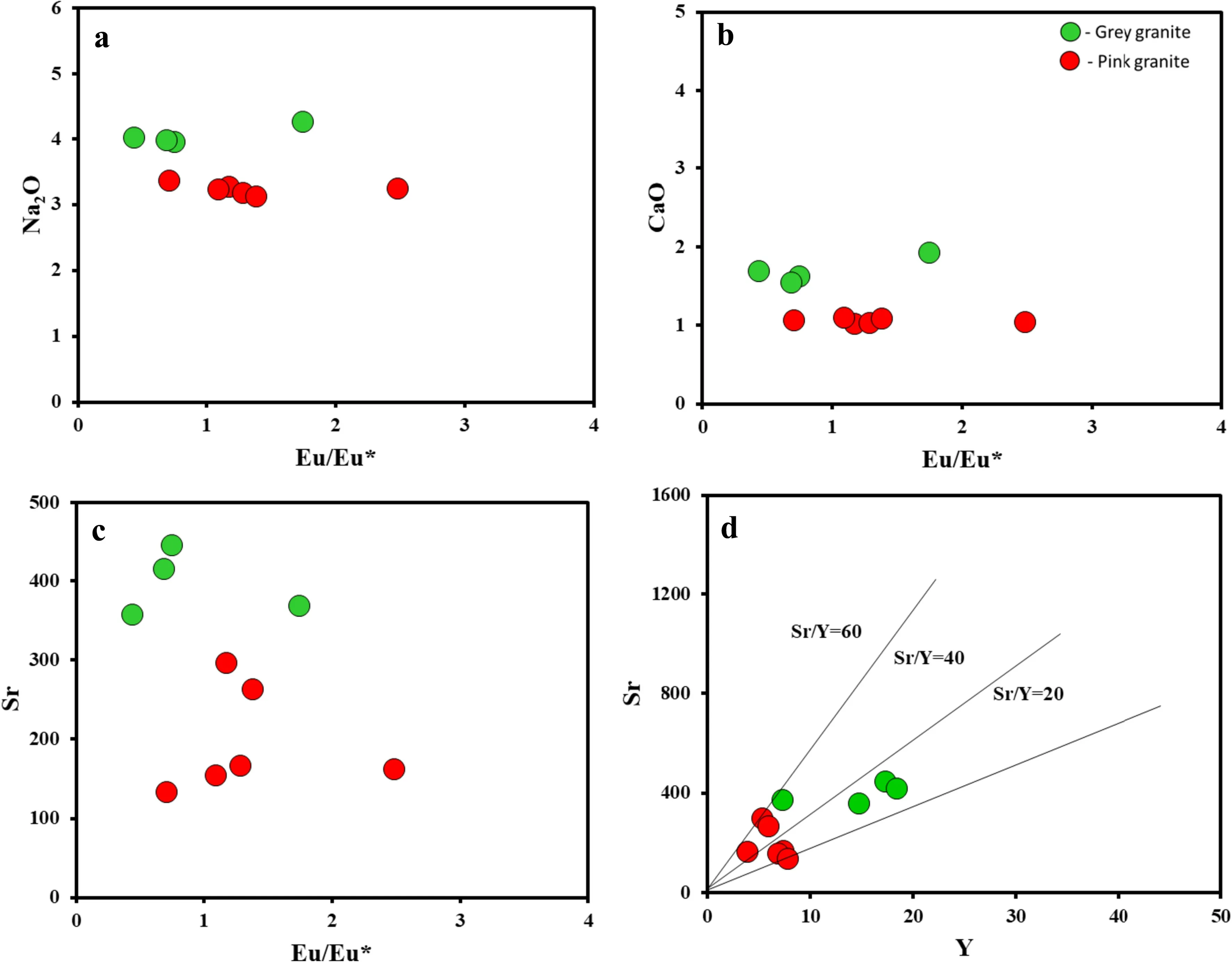
Fig.11 The variation of selected major and trace elements vs Eu/Eu* for Armoor granite explain crystal accumulation behavior: a Eu/Eu* vs Na2O;b Eu/Eu*vs CaO;c Eu/Eu*vs Sr;b Y vs S plot,Eu/Eu*normalized value represents REE Chondrite by Nakamura(1974),for Armoor granites (Zhou et al.2016)
Hydrothermal alteration is a set of chemical reactions that aims to bring hydrothermal fluids and rocks into chemical equilibrium.These processes affect the mineralogy,chemical composition,and textural properties of granitoids (Tata et al.2018).Fracture-controlled and less often occurring widespread modifications such as feldspathic,sericitic,silicic,and calc-silicate are common in these rocks.The Armor samples were the following primary alteration forms based on their mineralogy: K-feldspar alteration and sericitization with late carbonate and chlorite overprints (Fig.3c and d).The rocks within the K-feldspar interstices show varying degrees of alteration and plagioclase relics.Sericitized granitoid samples have a low Na2O content due to substituting sericite for plagioclase.The HFSC (Nb and Ta) exhibit no positive correlation with Zr (Fig.12),suggesting that these elements have been mobilized as a result of the alteration (Li and Wei 2017).The fluid fractionation phase is most likely responsible for the Rb enrichment in the Armoor samples with low Ba/Rb,K/Rb,and Nb/Ta ratios (Dostal and Chatterjee 2010;Shellnutt and Dostal 2012).Hydrothermal alteration methods have been discovered to impact on Eu anomaly chemical behavior (Bau 1991;Lottermoser 1992;Tata et al.2018).The Chondrite normalized values of grey granite (expect AMR-59) show higher TREE(247.6-502.38) and low Eu/Eu* (0.44-0.75),whereas grey granite (expect NPT-7) shows low TREE(81.54-434.48)and higher Eu/Eu*(1.1-2.49)(Nakamura 1974).The Chondrite normalized diagram shows dominantly negative Eu anomalies and enrichment of LREE of grey granites and dominantly positive Eu anomalies and depletion of LREE of pink granites,which indicate hydrothermal alteration dominantly influences the grey granites than pink granites (Fig.9a) (Nakamura 1974).
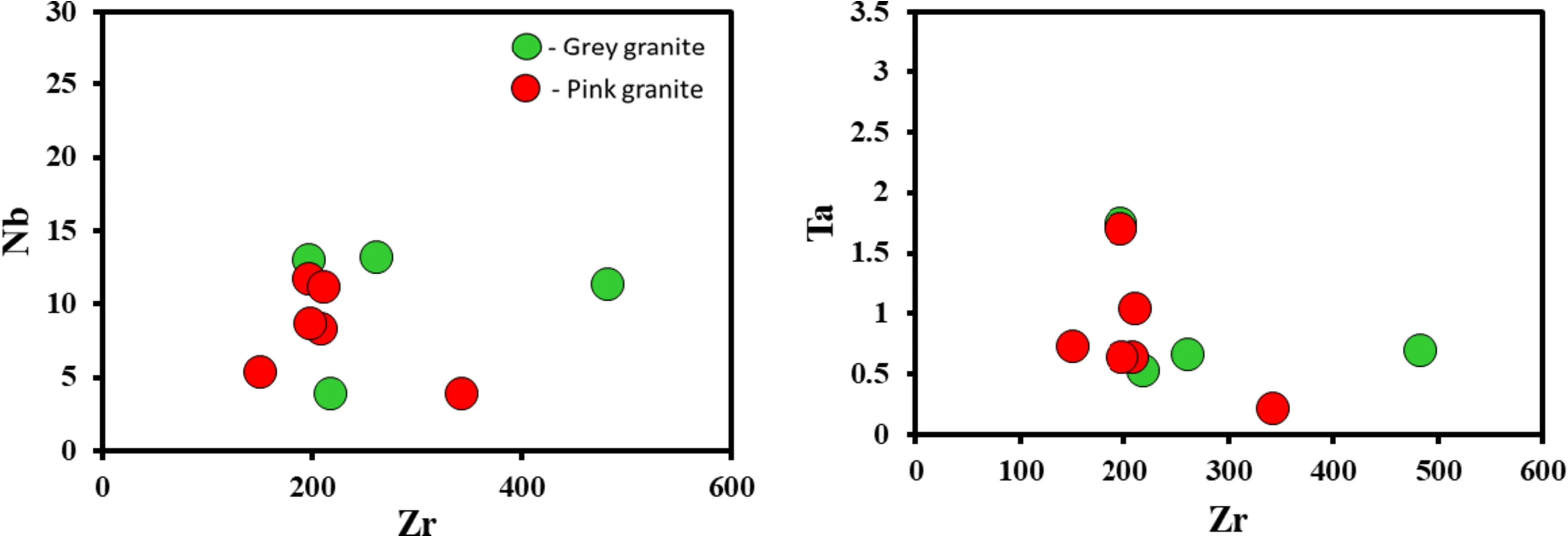
Fig.12 Zr vs Nb,Ta elements not showing clear positive correlation suggests post-magmatic alteration (Li and Wei 2017)
As indicated by the Th/U (0.6–10) and Zr/Hf(31.5-42.7) ratios,the aluminum saturation index of the meta-aluminous to the per-aluminous composition of Armoor granites indicates that these rocks produced through partial melting of continental crustal rocks (Kaygusuz et al.2016).Granites are positioned inside the remelting of the arc crust field on a source discrimination diagram (Fig.13a),indicating that they are derived from earlier crustal rocks.As a result,the ternary diagram(3CaO-Al2O3/ (FeOt+MgO)-5 × (K2O/Na2O) (Fig.13b)shows that the Armoor granites are produced by TTG and metasedimentary rocks (Laurent et al.2014).Previous experimental studies suggested that Neoarchean granites made up of K-rich biotite granites were found in almost all Archean cratons that had been clarified by the melting of older TTG’s and metasediments (Sylvester 1994;Moyen et al.2003;Laurent et al.2014;Jayananda et al.2019;Mohan et al.2019;Ajay Kumar et al.2022;Ranga et al.2022).
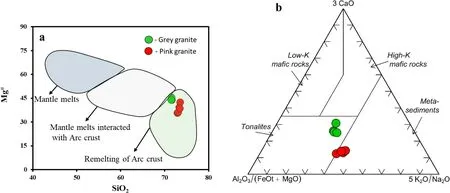
Fig.13 a Source discrimination diagram(with parameters SiO2 vs Mg#)the Armoor granite falls in the Crustal source(Jayananda et al.2018).b 3CaO–Al2O3/(FeOt+MgO)-5×(K2O/Na2O) triangular plot (Laurent et al.2014) depicting the sources of TTGs,and Metasediments
The majority of scientists have advocated the geodynamic two-stage growth model (Fig.11) for Neoarchean granites(Laurent et al.2014;Dey et al.2017;Mohan et al.2019),which is also relevant to the study area.During the transition from subduction to collision,the Neoarchean TTG of the EDC was formed,which represents the stage of phase 1 granitoids.These TTG were formed as a result of the melting of a subducting slab and its interaction with the preexisting crust.In phase 2,following the collision of the eastern and western cratonic blocks,the sanukitoid,K-rich,and hybrid granitoids variants were formed.In collisional environments,terrane accretion due to continent-continent collision resulting in crustal thickening,followed by slab breakoff or lithospheric delamination,may provide the necessary heat source.The thermal anomaly therefore produced by the collision would trigger partial melting and interactions between crust and mantle components,leading to the occurrence of sanukitoid,K-rich,and hybrid granites (Mikkola et al.2012;Moyen et al.2017).
Geochemical properties of Armoor granites prohibit their formation in the volcanic arc and collision conditions,which evolved during the late Archean time in EDC(Frost et al.2001;Clemens et al.2010).Negative Ba,Sr,Nb,and Ti anomalies on the primitive mantle normalized trace element distribution pattern of indicate a subduction zone setting (Fig.9b) (Sun and McDonough 1989).In addition,the HFSE systematics of these granites suggest that they are syn-collisional and of volcanic arc type in the setting of subduction (Fig.14) (Pearce et al.1984;Laurent et al.2014;Mohan et al.2019).Based on the previous workers and this work,K-rich Armoor granites formed by subduction to collision environment in the late Archean time,followed by remelting of older TTG and metasedimentary rocks.

Fig.14 Armoor granites fall in syn-collisional and volcanic arc settings of the Tectonic discrimination diagram (Pearce et al.1984).VAG-Volcanic granites,Syn-COLG-Syn collision granites,WPG-Within plate granites,ORG-Ocean ridge granites
7 Conclusions
The biotite mineral chemistry of examined granite implies their provenance-generating metaluminous (I-type) magnetite series(oxidized)granites in a calc-alkaline subduction tectonic context.The Armoor granite displays magnetite series with high Oxygen fugacity (fO2),which implies crystalizing under oxidized circumstances.The Armoor biotites solidified at the high oxidizing state of biotite development under the NNO buffer.Geochemically,the Armoor granites exhibit higher LREE over HREE,rich(Dy/Yb) and Sr/Y ratios,and negative and positive europium anomalies suggest that they are influenced by plagioclase accumulation and hydrothermal alteration.The Armoor granites show negative Ti,Sr,Ti,and Nb anomalies and high Sr/Y,which suggests the high-pressure melting of source material with garnet residue in a subduction setting.The current study demonstrates that the Armoor granites are generated by remelting older crustal sources.
AcknowledgementsThe authors thank the Head of the Department of Geology,Osmania University (Hyderabad),for petrography facilities.This work forms a part of the Ph.D.thesis of the first author.We acknowledge to Prof.M.Srinivas,Department of Geology,Osmania University,for his suggestions in the discussion part.Ak thanks the UGC (New Delhi),for awarding RGNFResearch Fellowship.We also thank Narahari,Senior Scientist,GSI-Hyderabad,for help with EPMA analysis.Dr.M.Ram Mohan,Chief Scientist and Dr.Keshava Krishna,Principal Scientist CSIR-NGRI,Hyderabad,for their help with ICP-MS and XRF analysis.The authors are grateful to the anonymous reviewers and handling editor for their constructive suggestions and comments which significantly improved this manuscript.
Declarations
Conflict of interestThe authors declare that they have no conflict of interest.
杂志排行
Acta Geochimica的其它文章
- The late Early-Paleozoic granitic magmatism in Northwestern Fujian,China: constraints on intraplate orogeny in the South China block
- Mineralogy and geochemistry of trachytic rocks from the Lichi Volcanics,Eastern Himalaya: insights into the Kerguelen mantle plume activity in the Eastern Himalayan Region
- Solute transport and geochemical modeling of the coastal quaternary aquifer,Delta Dahab Basin,South Sinai,Egypt
- Geochemistry,zircon U–Pb geochronology,and Hf isotopes of S-type granite in the Baoshan block,constraints on the age and evolution of the Proto-Tethys
- Distribution,health and ecological risk assessments of trace elements in Nigerian oil sands
- Petrogenesis and tectonic implications of the Silurian adakitic granitoids in the eastern segment of the Qilian Orogenic Belt,Northwest China
